Marketing Management Assignment: Value Proposition Analysis
VerifiedAdded on 2023/04/05
|15
|3850
|66
Report
AI Summary
This report analyzes the concept of value propositions in marketing, emphasizing how businesses create competitive advantages. It begins by defining value propositions as a promise of quality products and services at the best price, and it outlines the processes involved in their creation, including market analysis, customer feedback, competitive research, and research and development. The report then explores how value propositions drive competitive advantages, such as customer-focused product design, customer-centric business activities, and innovative marketing strategies. Furthermore, it evaluates the value propositions of companies operating in competitive markets, specifically focusing on the airline industry, and examines factors influencing consumer perception of value, including comfort, ticket availability, online services, and pricing. The report also discusses customer value-based marketing strategies, including safety, service quality, employee service, cultural segmentation, and aggressive marketing tactics, to create a positive value proposition. The report concludes by analyzing how companies use strategies like Porter's generic strategies and differentiation to create customer value and achieve a competitive edge in the market.
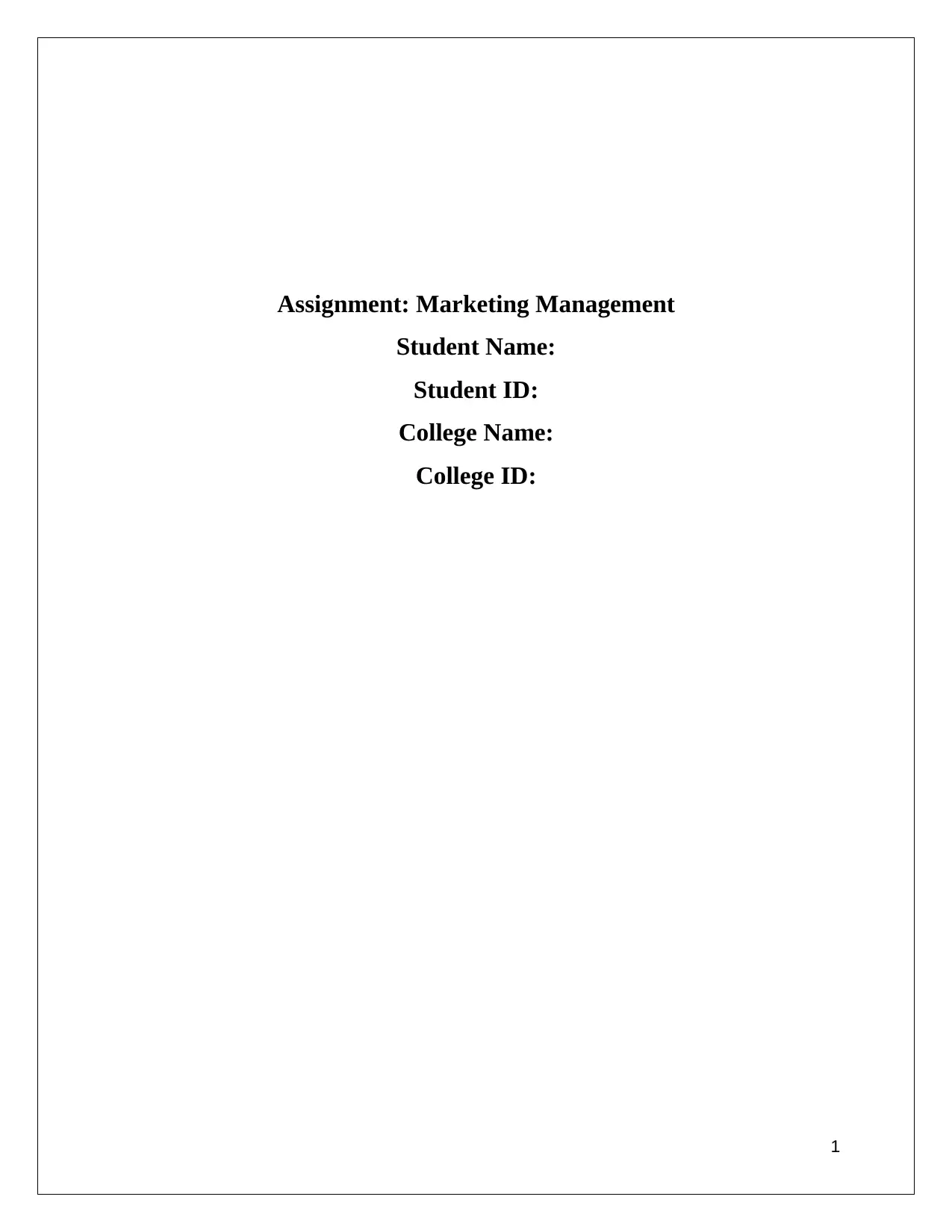
Assignment: Marketing Management
Student Name:
Student ID:
College Name:
College ID:
1
Student Name:
Student ID:
College Name:
College ID:
1
Secure Best Marks with AI Grader
Need help grading? Try our AI Grader for instant feedback on your assignments.
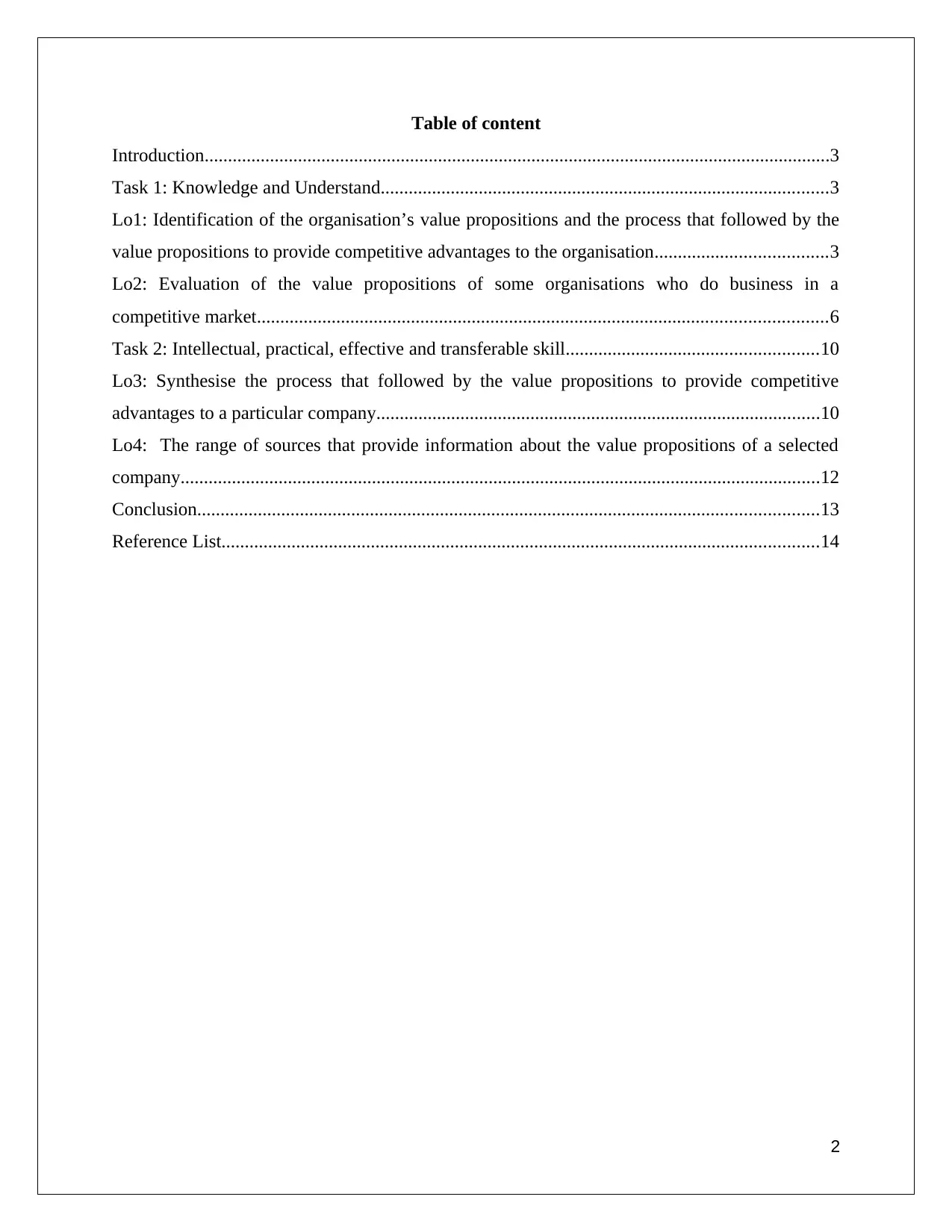
Table of content
Introduction......................................................................................................................................3
Task 1: Knowledge and Understand................................................................................................3
Lo1: Identification of the organisation’s value propositions and the process that followed by the
value propositions to provide competitive advantages to the organisation.....................................3
Lo2: Evaluation of the value propositions of some organisations who do business in a
competitive market..........................................................................................................................6
Task 2: Intellectual, practical, effective and transferable skill......................................................10
Lo3: Synthesise the process that followed by the value propositions to provide competitive
advantages to a particular company...............................................................................................10
Lo4: The range of sources that provide information about the value propositions of a selected
company.........................................................................................................................................12
Conclusion.....................................................................................................................................13
Reference List................................................................................................................................14
2
Introduction......................................................................................................................................3
Task 1: Knowledge and Understand................................................................................................3
Lo1: Identification of the organisation’s value propositions and the process that followed by the
value propositions to provide competitive advantages to the organisation.....................................3
Lo2: Evaluation of the value propositions of some organisations who do business in a
competitive market..........................................................................................................................6
Task 2: Intellectual, practical, effective and transferable skill......................................................10
Lo3: Synthesise the process that followed by the value propositions to provide competitive
advantages to a particular company...............................................................................................10
Lo4: The range of sources that provide information about the value propositions of a selected
company.........................................................................................................................................12
Conclusion.....................................................................................................................................13
Reference List................................................................................................................................14
2
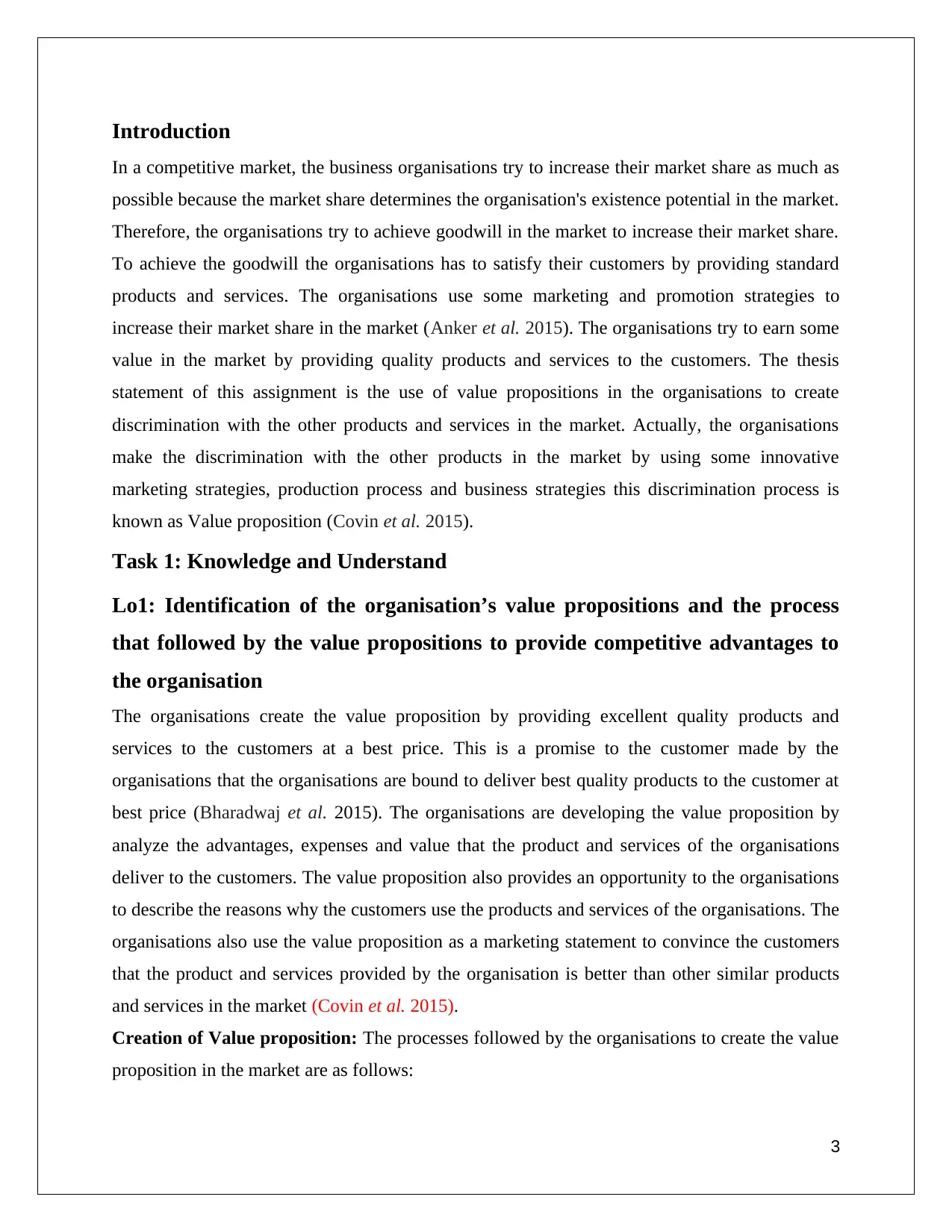
Introduction
In a competitive market, the business organisations try to increase their market share as much as
possible because the market share determines the organisation's existence potential in the market.
Therefore, the organisations try to achieve goodwill in the market to increase their market share.
To achieve the goodwill the organisations has to satisfy their customers by providing standard
products and services. The organisations use some marketing and promotion strategies to
increase their market share in the market (Anker et al. 2015). The organisations try to earn some
value in the market by providing quality products and services to the customers. The thesis
statement of this assignment is the use of value propositions in the organisations to create
discrimination with the other products and services in the market. Actually, the organisations
make the discrimination with the other products in the market by using some innovative
marketing strategies, production process and business strategies this discrimination process is
known as Value proposition (Covin et al. 2015).
Task 1: Knowledge and Understand
Lo1: Identification of the organisation’s value propositions and the process
that followed by the value propositions to provide competitive advantages to
the organisation
The organisations create the value proposition by providing excellent quality products and
services to the customers at a best price. This is a promise to the customer made by the
organisations that the organisations are bound to deliver best quality products to the customer at
best price (Bharadwaj et al. 2015). The organisations are developing the value proposition by
analyze the advantages, expenses and value that the product and services of the organisations
deliver to the customers. The value proposition also provides an opportunity to the organisations
to describe the reasons why the customers use the products and services of the organisations. The
organisations also use the value proposition as a marketing statement to convince the customers
that the product and services provided by the organisation is better than other similar products
and services in the market (Covin et al. 2015).
Creation of Value proposition: The processes followed by the organisations to create the value
proposition in the market are as follows:
3
In a competitive market, the business organisations try to increase their market share as much as
possible because the market share determines the organisation's existence potential in the market.
Therefore, the organisations try to achieve goodwill in the market to increase their market share.
To achieve the goodwill the organisations has to satisfy their customers by providing standard
products and services. The organisations use some marketing and promotion strategies to
increase their market share in the market (Anker et al. 2015). The organisations try to earn some
value in the market by providing quality products and services to the customers. The thesis
statement of this assignment is the use of value propositions in the organisations to create
discrimination with the other products and services in the market. Actually, the organisations
make the discrimination with the other products in the market by using some innovative
marketing strategies, production process and business strategies this discrimination process is
known as Value proposition (Covin et al. 2015).
Task 1: Knowledge and Understand
Lo1: Identification of the organisation’s value propositions and the process
that followed by the value propositions to provide competitive advantages to
the organisation
The organisations create the value proposition by providing excellent quality products and
services to the customers at a best price. This is a promise to the customer made by the
organisations that the organisations are bound to deliver best quality products to the customer at
best price (Bharadwaj et al. 2015). The organisations are developing the value proposition by
analyze the advantages, expenses and value that the product and services of the organisations
deliver to the customers. The value proposition also provides an opportunity to the organisations
to describe the reasons why the customers use the products and services of the organisations. The
organisations also use the value proposition as a marketing statement to convince the customers
that the product and services provided by the organisation is better than other similar products
and services in the market (Covin et al. 2015).
Creation of Value proposition: The processes followed by the organisations to create the value
proposition in the market are as follows:
3
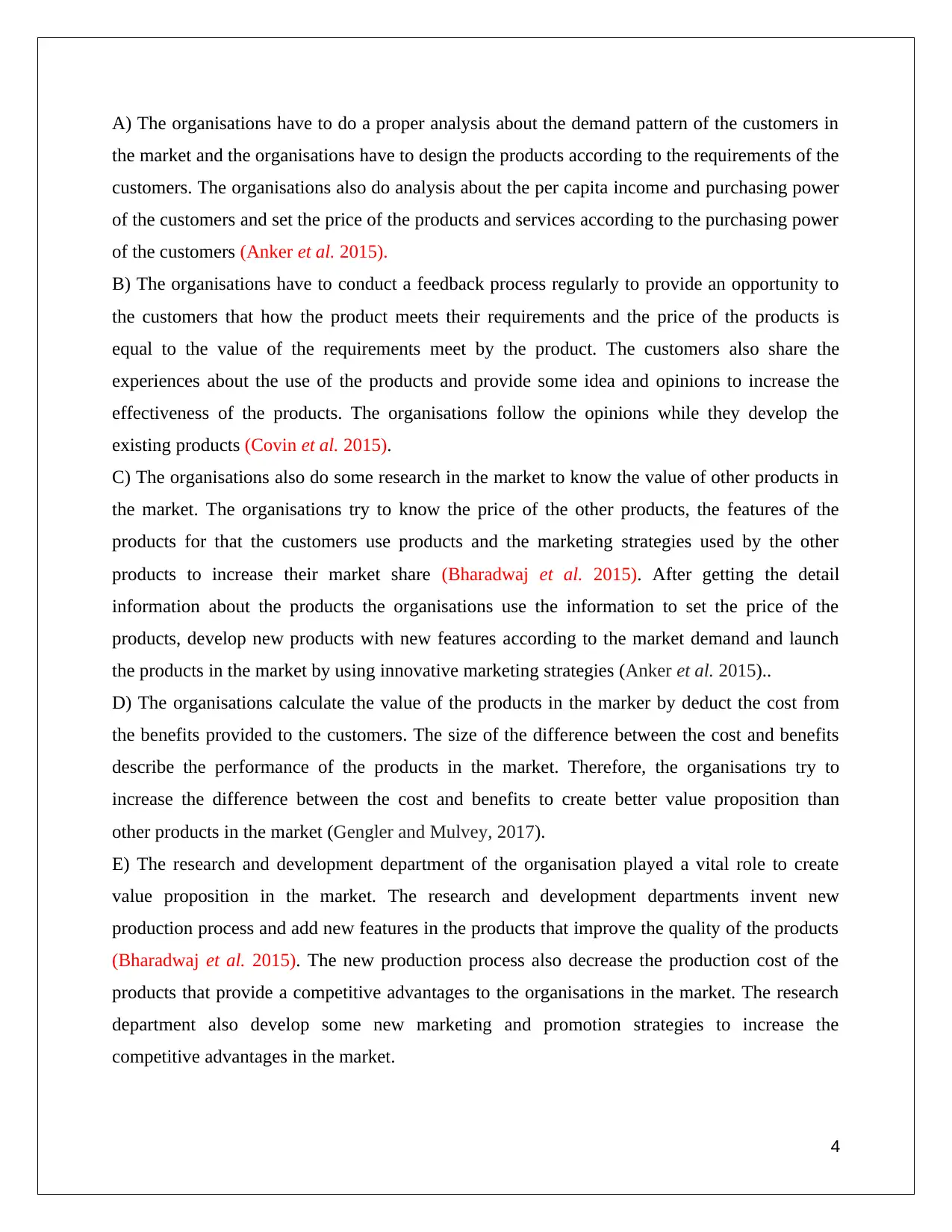
A) The organisations have to do a proper analysis about the demand pattern of the customers in
the market and the organisations have to design the products according to the requirements of the
customers. The organisations also do analysis about the per capita income and purchasing power
of the customers and set the price of the products and services according to the purchasing power
of the customers (Anker et al. 2015).
B) The organisations have to conduct a feedback process regularly to provide an opportunity to
the customers that how the product meets their requirements and the price of the products is
equal to the value of the requirements meet by the product. The customers also share the
experiences about the use of the products and provide some idea and opinions to increase the
effectiveness of the products. The organisations follow the opinions while they develop the
existing products (Covin et al. 2015).
C) The organisations also do some research in the market to know the value of other products in
the market. The organisations try to know the price of the other products, the features of the
products for that the customers use products and the marketing strategies used by the other
products to increase their market share (Bharadwaj et al. 2015). After getting the detail
information about the products the organisations use the information to set the price of the
products, develop new products with new features according to the market demand and launch
the products in the market by using innovative marketing strategies (Anker et al. 2015)..
D) The organisations calculate the value of the products in the marker by deduct the cost from
the benefits provided to the customers. The size of the difference between the cost and benefits
describe the performance of the products in the market. Therefore, the organisations try to
increase the difference between the cost and benefits to create better value proposition than
other products in the market (Gengler and Mulvey, 2017).
E) The research and development department of the organisation played a vital role to create
value proposition in the market. The research and development departments invent new
production process and add new features in the products that improve the quality of the products
(Bharadwaj et al. 2015). The new production process also decrease the production cost of the
products that provide a competitive advantages to the organisations in the market. The research
department also develop some new marketing and promotion strategies to increase the
competitive advantages in the market.
4
the market and the organisations have to design the products according to the requirements of the
customers. The organisations also do analysis about the per capita income and purchasing power
of the customers and set the price of the products and services according to the purchasing power
of the customers (Anker et al. 2015).
B) The organisations have to conduct a feedback process regularly to provide an opportunity to
the customers that how the product meets their requirements and the price of the products is
equal to the value of the requirements meet by the product. The customers also share the
experiences about the use of the products and provide some idea and opinions to increase the
effectiveness of the products. The organisations follow the opinions while they develop the
existing products (Covin et al. 2015).
C) The organisations also do some research in the market to know the value of other products in
the market. The organisations try to know the price of the other products, the features of the
products for that the customers use products and the marketing strategies used by the other
products to increase their market share (Bharadwaj et al. 2015). After getting the detail
information about the products the organisations use the information to set the price of the
products, develop new products with new features according to the market demand and launch
the products in the market by using innovative marketing strategies (Anker et al. 2015)..
D) The organisations calculate the value of the products in the marker by deduct the cost from
the benefits provided to the customers. The size of the difference between the cost and benefits
describe the performance of the products in the market. Therefore, the organisations try to
increase the difference between the cost and benefits to create better value proposition than
other products in the market (Gengler and Mulvey, 2017).
E) The research and development department of the organisation played a vital role to create
value proposition in the market. The research and development departments invent new
production process and add new features in the products that improve the quality of the products
(Bharadwaj et al. 2015). The new production process also decrease the production cost of the
products that provide a competitive advantages to the organisations in the market. The research
department also develop some new marketing and promotion strategies to increase the
competitive advantages in the market.
4
Secure Best Marks with AI Grader
Need help grading? Try our AI Grader for instant feedback on your assignments.
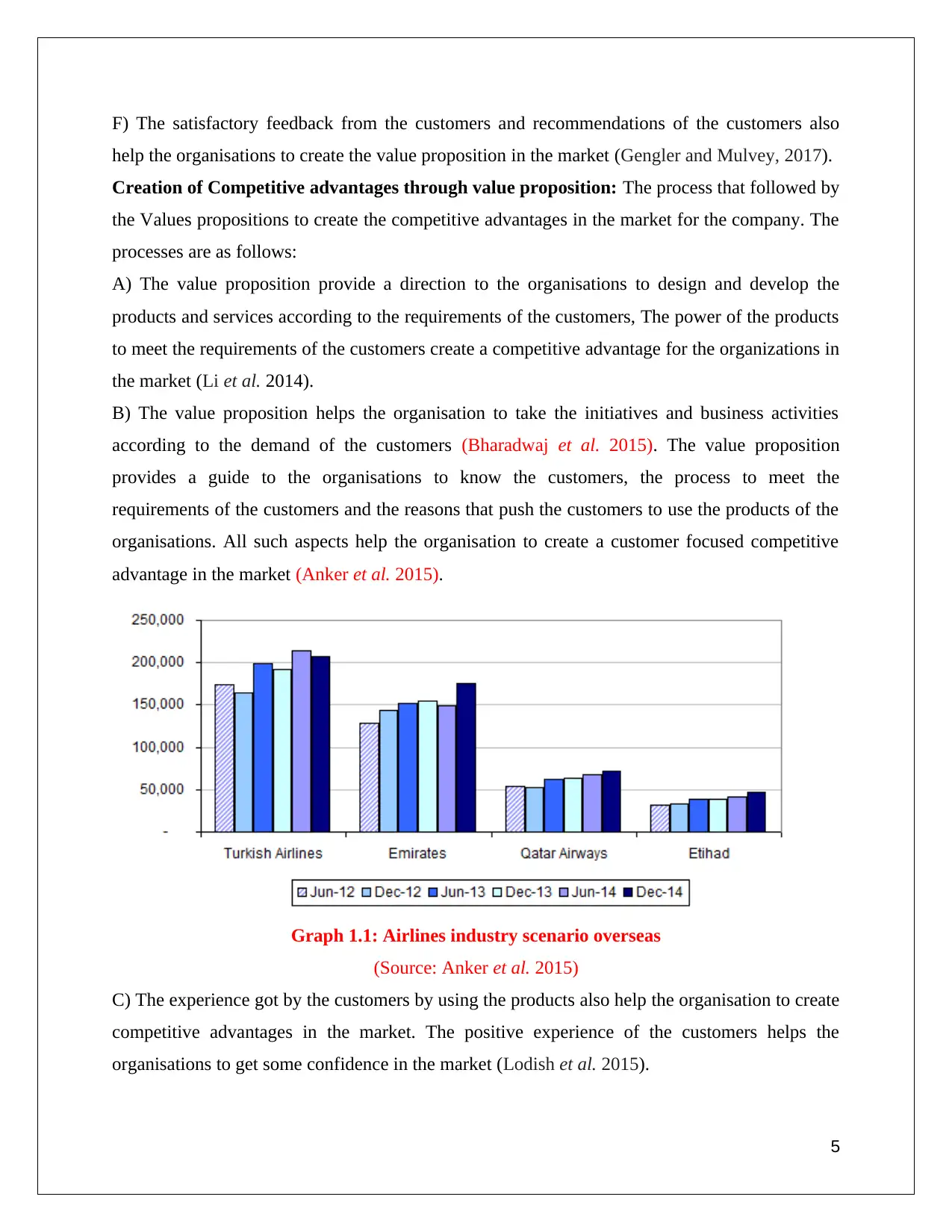
F) The satisfactory feedback from the customers and recommendations of the customers also
help the organisations to create the value proposition in the market (Gengler and Mulvey, 2017).
Creation of Competitive advantages through value proposition: The process that followed by
the Values propositions to create the competitive advantages in the market for the company. The
processes are as follows:
A) The value proposition provide a direction to the organisations to design and develop the
products and services according to the requirements of the customers, The power of the products
to meet the requirements of the customers create a competitive advantage for the organizations in
the market (Li et al. 2014).
B) The value proposition helps the organisation to take the initiatives and business activities
according to the demand of the customers (Bharadwaj et al. 2015). The value proposition
provides a guide to the organisations to know the customers, the process to meet the
requirements of the customers and the reasons that push the customers to use the products of the
organisations. All such aspects help the organisation to create a customer focused competitive
advantage in the market (Anker et al. 2015).
Graph 1.1: Airlines industry scenario overseas
(Source: Anker et al. 2015)
C) The experience got by the customers by using the products also help the organisation to create
competitive advantages in the market. The positive experience of the customers helps the
organisations to get some confidence in the market (Lodish et al. 2015).
5
help the organisations to create the value proposition in the market (Gengler and Mulvey, 2017).
Creation of Competitive advantages through value proposition: The process that followed by
the Values propositions to create the competitive advantages in the market for the company. The
processes are as follows:
A) The value proposition provide a direction to the organisations to design and develop the
products and services according to the requirements of the customers, The power of the products
to meet the requirements of the customers create a competitive advantage for the organizations in
the market (Li et al. 2014).
B) The value proposition helps the organisation to take the initiatives and business activities
according to the demand of the customers (Bharadwaj et al. 2015). The value proposition
provides a guide to the organisations to know the customers, the process to meet the
requirements of the customers and the reasons that push the customers to use the products of the
organisations. All such aspects help the organisation to create a customer focused competitive
advantage in the market (Anker et al. 2015).
Graph 1.1: Airlines industry scenario overseas
(Source: Anker et al. 2015)
C) The experience got by the customers by using the products also help the organisation to create
competitive advantages in the market. The positive experience of the customers helps the
organisations to get some confidence in the market (Lodish et al. 2015).
5
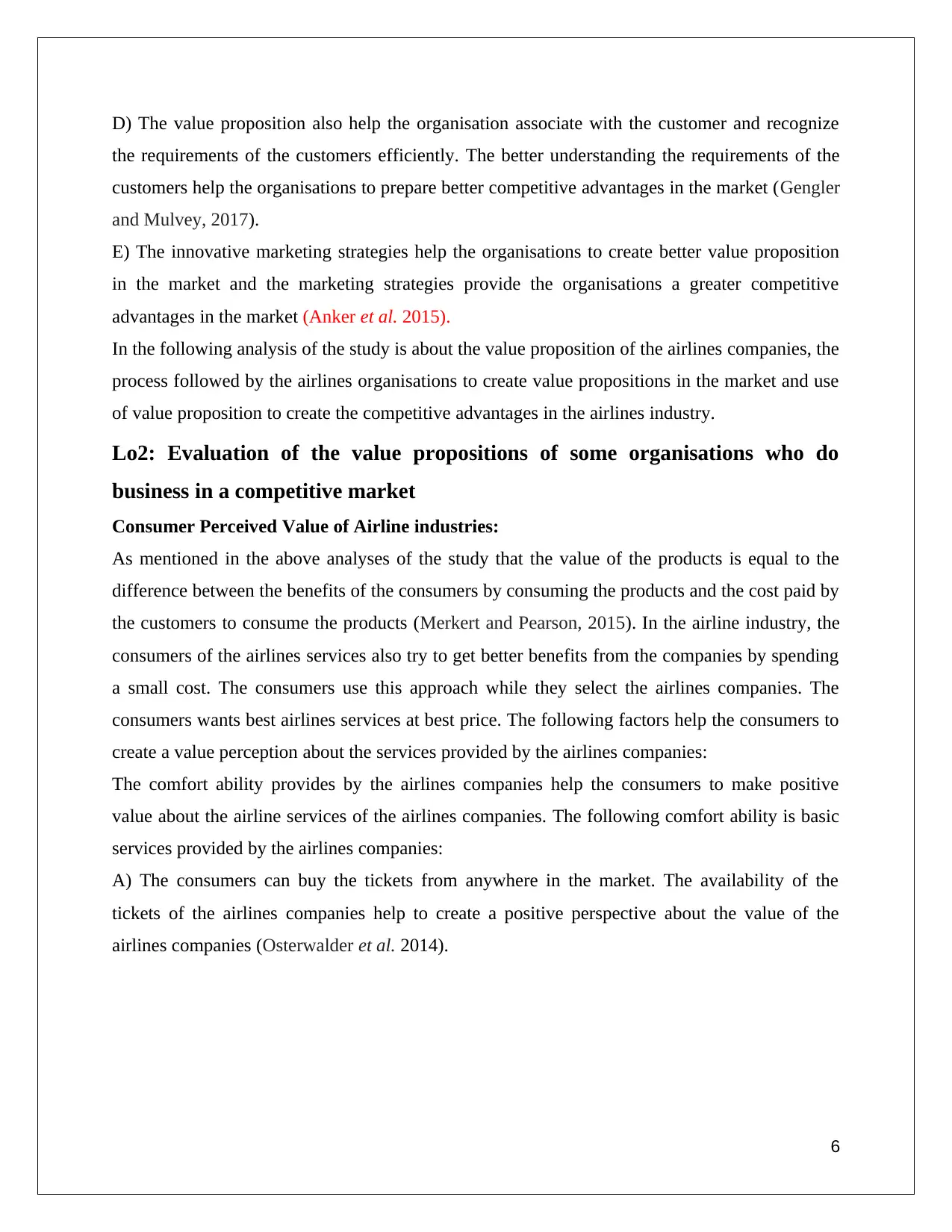
D) The value proposition also help the organisation associate with the customer and recognize
the requirements of the customers efficiently. The better understanding the requirements of the
customers help the organisations to prepare better competitive advantages in the market (Gengler
and Mulvey, 2017).
E) The innovative marketing strategies help the organisations to create better value proposition
in the market and the marketing strategies provide the organisations a greater competitive
advantages in the market (Anker et al. 2015).
In the following analysis of the study is about the value proposition of the airlines companies, the
process followed by the airlines organisations to create value propositions in the market and use
of value proposition to create the competitive advantages in the airlines industry.
Lo2: Evaluation of the value propositions of some organisations who do
business in a competitive market
Consumer Perceived Value of Airline industries:
As mentioned in the above analyses of the study that the value of the products is equal to the
difference between the benefits of the consumers by consuming the products and the cost paid by
the customers to consume the products (Merkert and Pearson, 2015). In the airline industry, the
consumers of the airlines services also try to get better benefits from the companies by spending
a small cost. The consumers use this approach while they select the airlines companies. The
consumers wants best airlines services at best price. The following factors help the consumers to
create a value perception about the services provided by the airlines companies:
The comfort ability provides by the airlines companies help the consumers to make positive
value about the airline services of the airlines companies. The following comfort ability is basic
services provided by the airlines companies:
A) The consumers can buy the tickets from anywhere in the market. The availability of the
tickets of the airlines companies help to create a positive perspective about the value of the
airlines companies (Osterwalder et al. 2014).
6
the requirements of the customers efficiently. The better understanding the requirements of the
customers help the organisations to prepare better competitive advantages in the market (Gengler
and Mulvey, 2017).
E) The innovative marketing strategies help the organisations to create better value proposition
in the market and the marketing strategies provide the organisations a greater competitive
advantages in the market (Anker et al. 2015).
In the following analysis of the study is about the value proposition of the airlines companies, the
process followed by the airlines organisations to create value propositions in the market and use
of value proposition to create the competitive advantages in the airlines industry.
Lo2: Evaluation of the value propositions of some organisations who do
business in a competitive market
Consumer Perceived Value of Airline industries:
As mentioned in the above analyses of the study that the value of the products is equal to the
difference between the benefits of the consumers by consuming the products and the cost paid by
the customers to consume the products (Merkert and Pearson, 2015). In the airline industry, the
consumers of the airlines services also try to get better benefits from the companies by spending
a small cost. The consumers use this approach while they select the airlines companies. The
consumers wants best airlines services at best price. The following factors help the consumers to
create a value perception about the services provided by the airlines companies:
The comfort ability provides by the airlines companies help the consumers to make positive
value about the airline services of the airlines companies. The following comfort ability is basic
services provided by the airlines companies:
A) The consumers can buy the tickets from anywhere in the market. The availability of the
tickets of the airlines companies help to create a positive perspective about the value of the
airlines companies (Osterwalder et al. 2014).
6
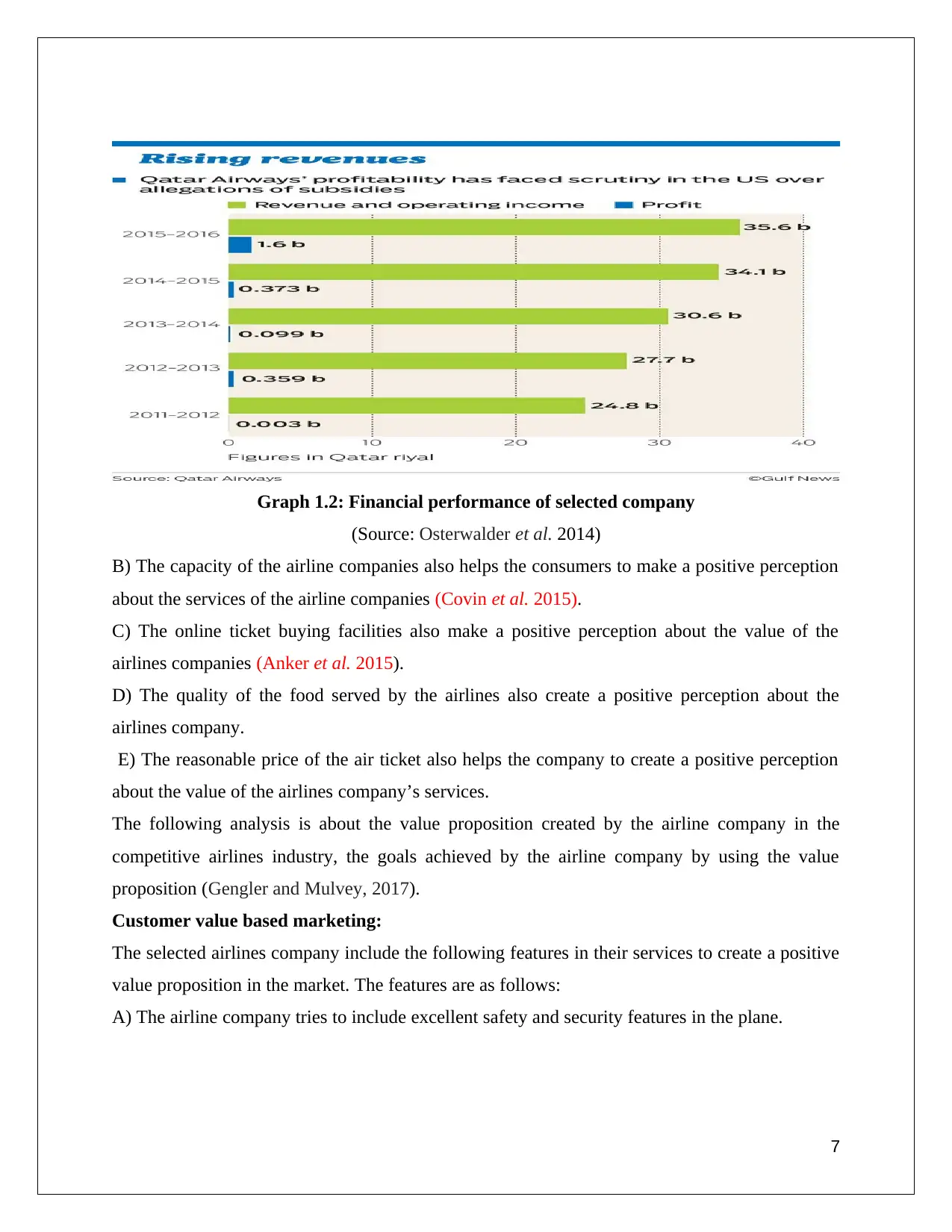
Graph 1.2: Financial performance of selected company
(Source: Osterwalder et al. 2014)
B) The capacity of the airline companies also helps the consumers to make a positive perception
about the services of the airline companies (Covin et al. 2015).
C) The online ticket buying facilities also make a positive perception about the value of the
airlines companies (Anker et al. 2015).
D) The quality of the food served by the airlines also create a positive perception about the
airlines company.
E) The reasonable price of the air ticket also helps the company to create a positive perception
about the value of the airlines company’s services.
The following analysis is about the value proposition created by the airline company in the
competitive airlines industry, the goals achieved by the airline company by using the value
proposition (Gengler and Mulvey, 2017).
Customer value based marketing:
The selected airlines company include the following features in their services to create a positive
value proposition in the market. The features are as follows:
A) The airline company tries to include excellent safety and security features in the plane.
7
(Source: Osterwalder et al. 2014)
B) The capacity of the airline companies also helps the consumers to make a positive perception
about the services of the airline companies (Covin et al. 2015).
C) The online ticket buying facilities also make a positive perception about the value of the
airlines companies (Anker et al. 2015).
D) The quality of the food served by the airlines also create a positive perception about the
airlines company.
E) The reasonable price of the air ticket also helps the company to create a positive perception
about the value of the airlines company’s services.
The following analysis is about the value proposition created by the airline company in the
competitive airlines industry, the goals achieved by the airline company by using the value
proposition (Gengler and Mulvey, 2017).
Customer value based marketing:
The selected airlines company include the following features in their services to create a positive
value proposition in the market. The features are as follows:
A) The airline company tries to include excellent safety and security features in the plane.
7
Paraphrase This Document
Need a fresh take? Get an instant paraphrase of this document with our AI Paraphraser

B) The company provides excellent quality services and hospitality to the customers and the
service of the company try to fulfil individual passenger’s requirements (Gengler and Mulvey,
2017).
C) The employees of the airline company also provide excellent services to the customers.
D) The airline company create the segmentation of the customers according to the culture and
background of the customers and the company try to provide the services according to the
cultural segments to the customers (Payne and Frow, 2014).
E) The aggressive marketing strategies and discount offers in the ticket price help the company
to increase their market share in the airlines industry. The company also create a positive value
proposition in the market by their excellent services and hospitality.
Customer Value Strategy and positioning:
The Airlines company also use some strategies and plans to create a proper customer value in the
airline industry. The strategies are as follows:
The airline company use the Porter’s generic strategies to know the strength that help them to
create a value in the market. After analyzing the strategies, the company recognise that in the
competitive industry the company has to provide the services at reasonable price. The strength to
set the price of the tickets according to the purchasing power of the customers help the company
to create a value in the industry. The bargaining power with the oil suppliers also helps the
company to buy the oil at a reasonable price. The low oil price helps the company to reduce their
cost and increase the profit (Pearson et al. 2015). The company also provide some discount to the
customers due to the low price in oil. The low oil cost of the company reduces the operation cost
of the company and it completes the cost leadership strategies of the company efficiently. This
kinds of incidents help the company to create a value in the industry. The research and
development department of the company also keep the company up to date with the new
technologies. The use of new technologies in the services help the company to improve the
quality of the services provided to the customers. The company also follow the differentiation
strategy in the services. According to differentiation strategy, the company create large service
segmentation based on the price of the tickets (Ponte et al. 2015). The customers who preferred
light travel they can buy the ticket at lower price and the customers who preferred luxurious
facilities during the travel they can buy the ticket of higher prices. This segmentation make the
service of the company affordable to everyone and this affordability help the company to create a
8
service of the company try to fulfil individual passenger’s requirements (Gengler and Mulvey,
2017).
C) The employees of the airline company also provide excellent services to the customers.
D) The airline company create the segmentation of the customers according to the culture and
background of the customers and the company try to provide the services according to the
cultural segments to the customers (Payne and Frow, 2014).
E) The aggressive marketing strategies and discount offers in the ticket price help the company
to increase their market share in the airlines industry. The company also create a positive value
proposition in the market by their excellent services and hospitality.
Customer Value Strategy and positioning:
The Airlines company also use some strategies and plans to create a proper customer value in the
airline industry. The strategies are as follows:
The airline company use the Porter’s generic strategies to know the strength that help them to
create a value in the market. After analyzing the strategies, the company recognise that in the
competitive industry the company has to provide the services at reasonable price. The strength to
set the price of the tickets according to the purchasing power of the customers help the company
to create a value in the industry. The bargaining power with the oil suppliers also helps the
company to buy the oil at a reasonable price. The low oil price helps the company to reduce their
cost and increase the profit (Pearson et al. 2015). The company also provide some discount to the
customers due to the low price in oil. The low oil cost of the company reduces the operation cost
of the company and it completes the cost leadership strategies of the company efficiently. This
kinds of incidents help the company to create a value in the industry. The research and
development department of the company also keep the company up to date with the new
technologies. The use of new technologies in the services help the company to improve the
quality of the services provided to the customers. The company also follow the differentiation
strategy in the services. According to differentiation strategy, the company create large service
segmentation based on the price of the tickets (Ponte et al. 2015). The customers who preferred
light travel they can buy the ticket at lower price and the customers who preferred luxurious
facilities during the travel they can buy the ticket of higher prices. This segmentation make the
service of the company affordable to everyone and this affordability help the company to create a
8
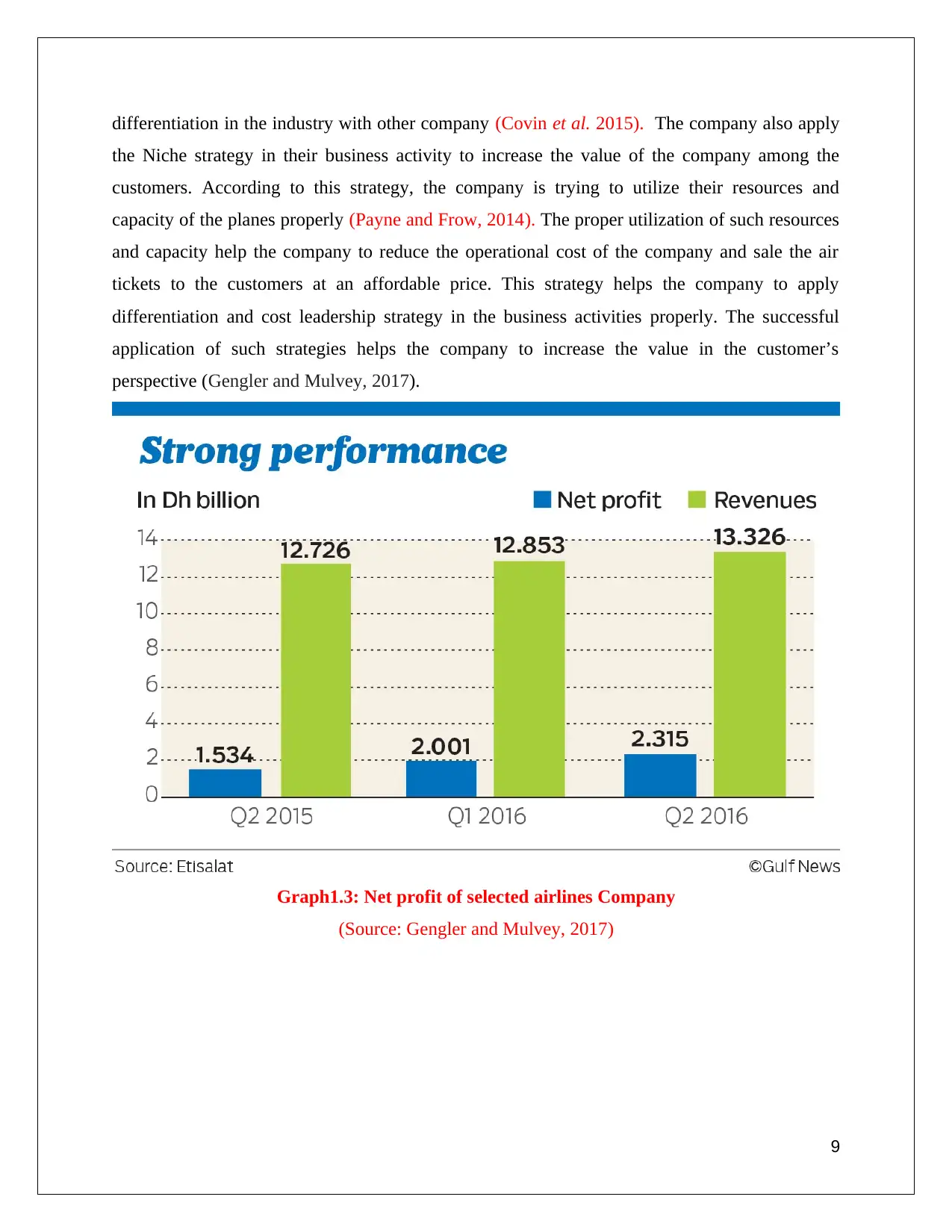
differentiation in the industry with other company (Covin et al. 2015). The company also apply
the Niche strategy in their business activity to increase the value of the company among the
customers. According to this strategy, the company is trying to utilize their resources and
capacity of the planes properly (Payne and Frow, 2014). The proper utilization of such resources
and capacity help the company to reduce the operational cost of the company and sale the air
tickets to the customers at an affordable price. This strategy helps the company to apply
differentiation and cost leadership strategy in the business activities properly. The successful
application of such strategies helps the company to increase the value in the customer’s
perspective (Gengler and Mulvey, 2017).
Graph1.3: Net profit of selected airlines Company
(Source: Gengler and Mulvey, 2017)
9
the Niche strategy in their business activity to increase the value of the company among the
customers. According to this strategy, the company is trying to utilize their resources and
capacity of the planes properly (Payne and Frow, 2014). The proper utilization of such resources
and capacity help the company to reduce the operational cost of the company and sale the air
tickets to the customers at an affordable price. This strategy helps the company to apply
differentiation and cost leadership strategy in the business activities properly. The successful
application of such strategies helps the company to increase the value in the customer’s
perspective (Gengler and Mulvey, 2017).
Graph1.3: Net profit of selected airlines Company
(Source: Gengler and Mulvey, 2017)
9
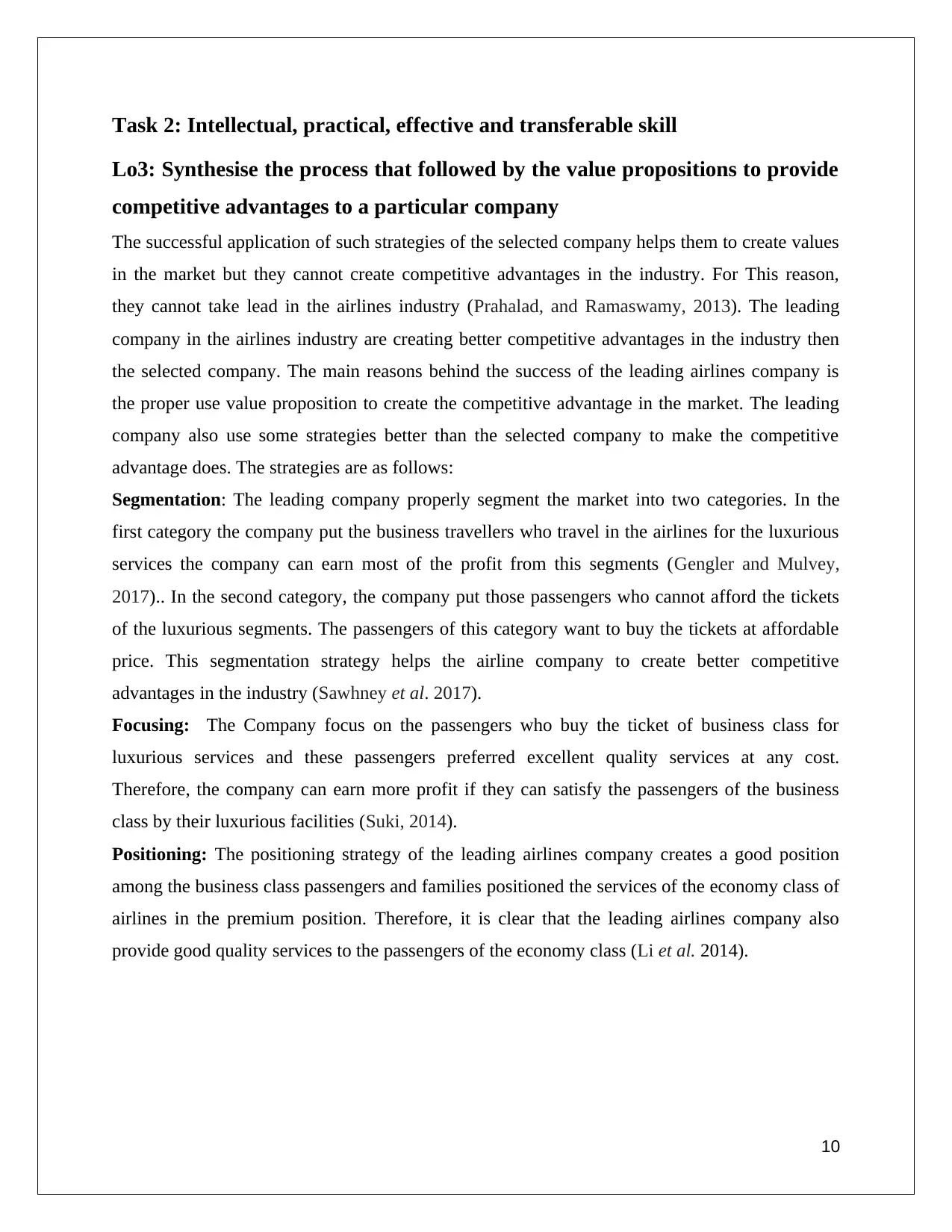
Task 2: Intellectual, practical, effective and transferable skill
Lo3: Synthesise the process that followed by the value propositions to provide
competitive advantages to a particular company
The successful application of such strategies of the selected company helps them to create values
in the market but they cannot create competitive advantages in the industry. For This reason,
they cannot take lead in the airlines industry (Prahalad, and Ramaswamy, 2013). The leading
company in the airlines industry are creating better competitive advantages in the industry then
the selected company. The main reasons behind the success of the leading airlines company is
the proper use value proposition to create the competitive advantage in the market. The leading
company also use some strategies better than the selected company to make the competitive
advantage does. The strategies are as follows:
Segmentation: The leading company properly segment the market into two categories. In the
first category the company put the business travellers who travel in the airlines for the luxurious
services the company can earn most of the profit from this segments (Gengler and Mulvey,
2017).. In the second category, the company put those passengers who cannot afford the tickets
of the luxurious segments. The passengers of this category want to buy the tickets at affordable
price. This segmentation strategy helps the airline company to create better competitive
advantages in the industry (Sawhney et al. 2017).
Focusing: The Company focus on the passengers who buy the ticket of business class for
luxurious services and these passengers preferred excellent quality services at any cost.
Therefore, the company can earn more profit if they can satisfy the passengers of the business
class by their luxurious facilities (Suki, 2014).
Positioning: The positioning strategy of the leading airlines company creates a good position
among the business class passengers and families positioned the services of the economy class of
airlines in the premium position. Therefore, it is clear that the leading airlines company also
provide good quality services to the passengers of the economy class (Li et al. 2014).
10
Lo3: Synthesise the process that followed by the value propositions to provide
competitive advantages to a particular company
The successful application of such strategies of the selected company helps them to create values
in the market but they cannot create competitive advantages in the industry. For This reason,
they cannot take lead in the airlines industry (Prahalad, and Ramaswamy, 2013). The leading
company in the airlines industry are creating better competitive advantages in the industry then
the selected company. The main reasons behind the success of the leading airlines company is
the proper use value proposition to create the competitive advantage in the market. The leading
company also use some strategies better than the selected company to make the competitive
advantage does. The strategies are as follows:
Segmentation: The leading company properly segment the market into two categories. In the
first category the company put the business travellers who travel in the airlines for the luxurious
services the company can earn most of the profit from this segments (Gengler and Mulvey,
2017).. In the second category, the company put those passengers who cannot afford the tickets
of the luxurious segments. The passengers of this category want to buy the tickets at affordable
price. This segmentation strategy helps the airline company to create better competitive
advantages in the industry (Sawhney et al. 2017).
Focusing: The Company focus on the passengers who buy the ticket of business class for
luxurious services and these passengers preferred excellent quality services at any cost.
Therefore, the company can earn more profit if they can satisfy the passengers of the business
class by their luxurious facilities (Suki, 2014).
Positioning: The positioning strategy of the leading airlines company creates a good position
among the business class passengers and families positioned the services of the economy class of
airlines in the premium position. Therefore, it is clear that the leading airlines company also
provide good quality services to the passengers of the economy class (Li et al. 2014).
10
Secure Best Marks with AI Grader
Need help grading? Try our AI Grader for instant feedback on your assignments.
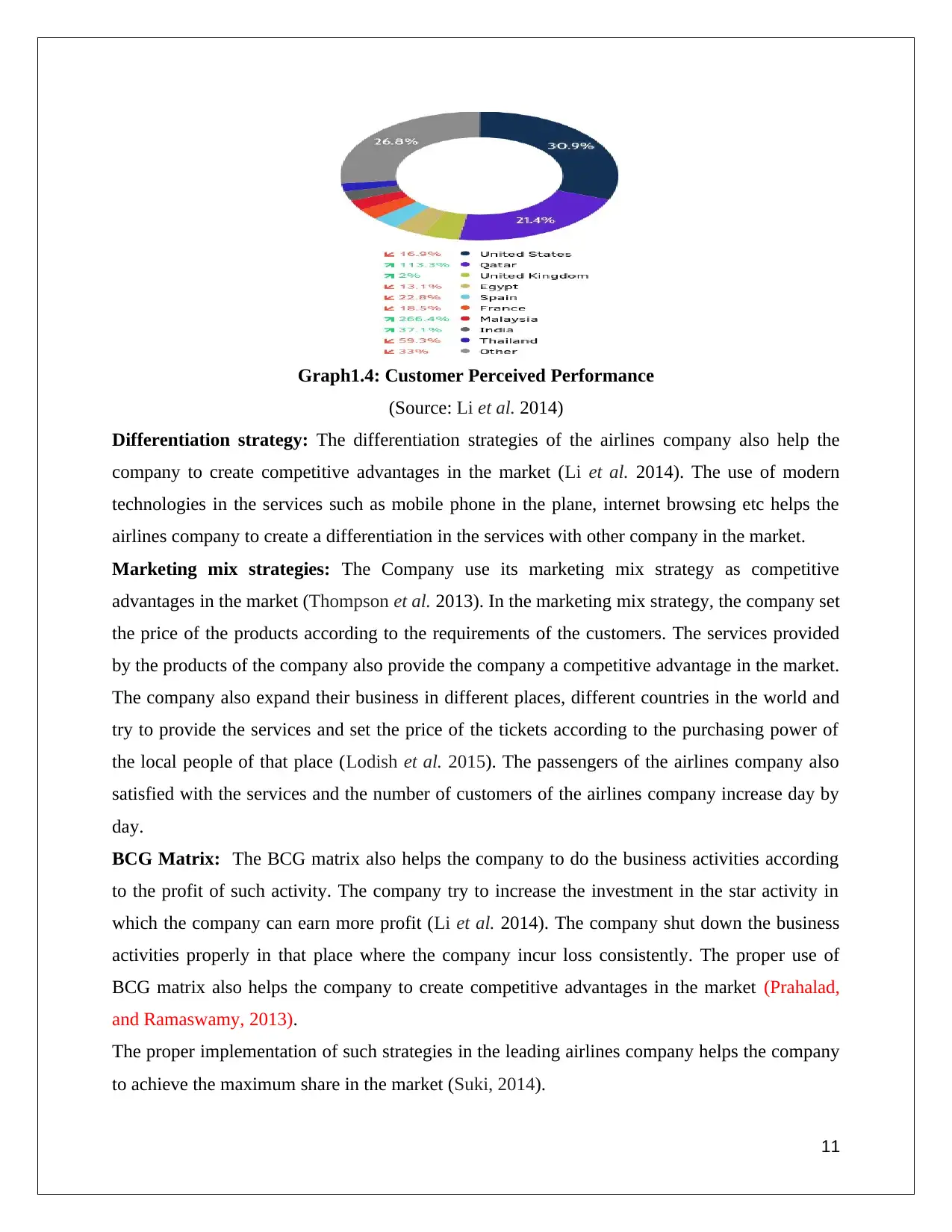
Graph1.4: Customer Perceived Performance
(Source: Li et al. 2014)
Differentiation strategy: The differentiation strategies of the airlines company also help the
company to create competitive advantages in the market (Li et al. 2014). The use of modern
technologies in the services such as mobile phone in the plane, internet browsing etc helps the
airlines company to create a differentiation in the services with other company in the market.
Marketing mix strategies: The Company use its marketing mix strategy as competitive
advantages in the market (Thompson et al. 2013). In the marketing mix strategy, the company set
the price of the products according to the requirements of the customers. The services provided
by the products of the company also provide the company a competitive advantage in the market.
The company also expand their business in different places, different countries in the world and
try to provide the services and set the price of the tickets according to the purchasing power of
the local people of that place (Lodish et al. 2015). The passengers of the airlines company also
satisfied with the services and the number of customers of the airlines company increase day by
day.
BCG Matrix: The BCG matrix also helps the company to do the business activities according
to the profit of such activity. The company try to increase the investment in the star activity in
which the company can earn more profit (Li et al. 2014). The company shut down the business
activities properly in that place where the company incur loss consistently. The proper use of
BCG matrix also helps the company to create competitive advantages in the market (Prahalad,
and Ramaswamy, 2013).
The proper implementation of such strategies in the leading airlines company helps the company
to achieve the maximum share in the market (Suki, 2014).
11
(Source: Li et al. 2014)
Differentiation strategy: The differentiation strategies of the airlines company also help the
company to create competitive advantages in the market (Li et al. 2014). The use of modern
technologies in the services such as mobile phone in the plane, internet browsing etc helps the
airlines company to create a differentiation in the services with other company in the market.
Marketing mix strategies: The Company use its marketing mix strategy as competitive
advantages in the market (Thompson et al. 2013). In the marketing mix strategy, the company set
the price of the products according to the requirements of the customers. The services provided
by the products of the company also provide the company a competitive advantage in the market.
The company also expand their business in different places, different countries in the world and
try to provide the services and set the price of the tickets according to the purchasing power of
the local people of that place (Lodish et al. 2015). The passengers of the airlines company also
satisfied with the services and the number of customers of the airlines company increase day by
day.
BCG Matrix: The BCG matrix also helps the company to do the business activities according
to the profit of such activity. The company try to increase the investment in the star activity in
which the company can earn more profit (Li et al. 2014). The company shut down the business
activities properly in that place where the company incur loss consistently. The proper use of
BCG matrix also helps the company to create competitive advantages in the market (Prahalad,
and Ramaswamy, 2013).
The proper implementation of such strategies in the leading airlines company helps the company
to achieve the maximum share in the market (Suki, 2014).
11
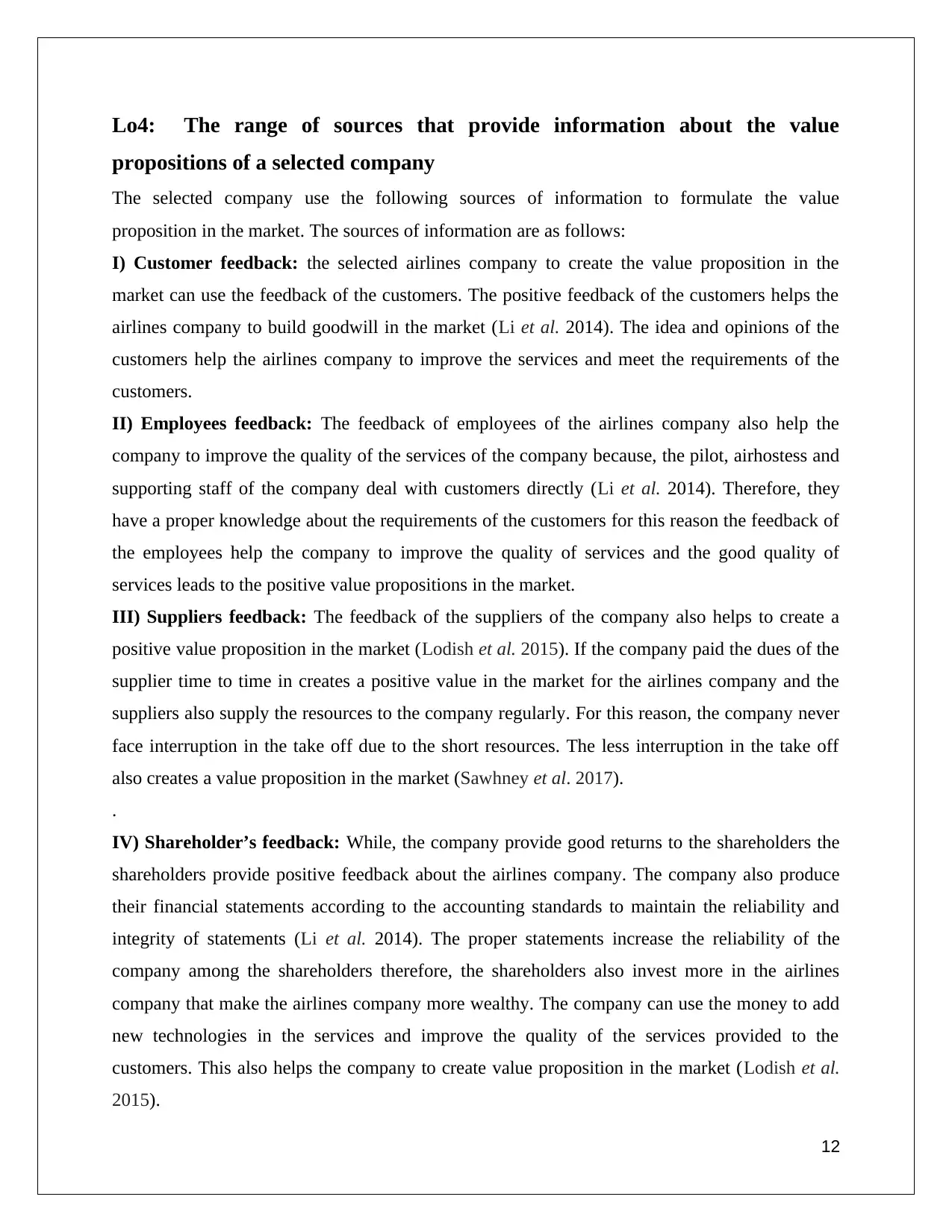
Lo4: The range of sources that provide information about the value
propositions of a selected company
The selected company use the following sources of information to formulate the value
proposition in the market. The sources of information are as follows:
I) Customer feedback: the selected airlines company to create the value proposition in the
market can use the feedback of the customers. The positive feedback of the customers helps the
airlines company to build goodwill in the market (Li et al. 2014). The idea and opinions of the
customers help the airlines company to improve the services and meet the requirements of the
customers.
II) Employees feedback: The feedback of employees of the airlines company also help the
company to improve the quality of the services of the company because, the pilot, airhostess and
supporting staff of the company deal with customers directly (Li et al. 2014). Therefore, they
have a proper knowledge about the requirements of the customers for this reason the feedback of
the employees help the company to improve the quality of services and the good quality of
services leads to the positive value propositions in the market.
III) Suppliers feedback: The feedback of the suppliers of the company also helps to create a
positive value proposition in the market (Lodish et al. 2015). If the company paid the dues of the
supplier time to time in creates a positive value in the market for the airlines company and the
suppliers also supply the resources to the company regularly. For this reason, the company never
face interruption in the take off due to the short resources. The less interruption in the take off
also creates a value proposition in the market (Sawhney et al. 2017).
.
IV) Shareholder’s feedback: While, the company provide good returns to the shareholders the
shareholders provide positive feedback about the airlines company. The company also produce
their financial statements according to the accounting standards to maintain the reliability and
integrity of statements (Li et al. 2014). The proper statements increase the reliability of the
company among the shareholders therefore, the shareholders also invest more in the airlines
company that make the airlines company more wealthy. The company can use the money to add
new technologies in the services and improve the quality of the services provided to the
customers. This also helps the company to create value proposition in the market (Lodish et al.
2015).
12
propositions of a selected company
The selected company use the following sources of information to formulate the value
proposition in the market. The sources of information are as follows:
I) Customer feedback: the selected airlines company to create the value proposition in the
market can use the feedback of the customers. The positive feedback of the customers helps the
airlines company to build goodwill in the market (Li et al. 2014). The idea and opinions of the
customers help the airlines company to improve the services and meet the requirements of the
customers.
II) Employees feedback: The feedback of employees of the airlines company also help the
company to improve the quality of the services of the company because, the pilot, airhostess and
supporting staff of the company deal with customers directly (Li et al. 2014). Therefore, they
have a proper knowledge about the requirements of the customers for this reason the feedback of
the employees help the company to improve the quality of services and the good quality of
services leads to the positive value propositions in the market.
III) Suppliers feedback: The feedback of the suppliers of the company also helps to create a
positive value proposition in the market (Lodish et al. 2015). If the company paid the dues of the
supplier time to time in creates a positive value in the market for the airlines company and the
suppliers also supply the resources to the company regularly. For this reason, the company never
face interruption in the take off due to the short resources. The less interruption in the take off
also creates a value proposition in the market (Sawhney et al. 2017).
.
IV) Shareholder’s feedback: While, the company provide good returns to the shareholders the
shareholders provide positive feedback about the airlines company. The company also produce
their financial statements according to the accounting standards to maintain the reliability and
integrity of statements (Li et al. 2014). The proper statements increase the reliability of the
company among the shareholders therefore, the shareholders also invest more in the airlines
company that make the airlines company more wealthy. The company can use the money to add
new technologies in the services and improve the quality of the services provided to the
customers. This also helps the company to create value proposition in the market (Lodish et al.
2015).
12
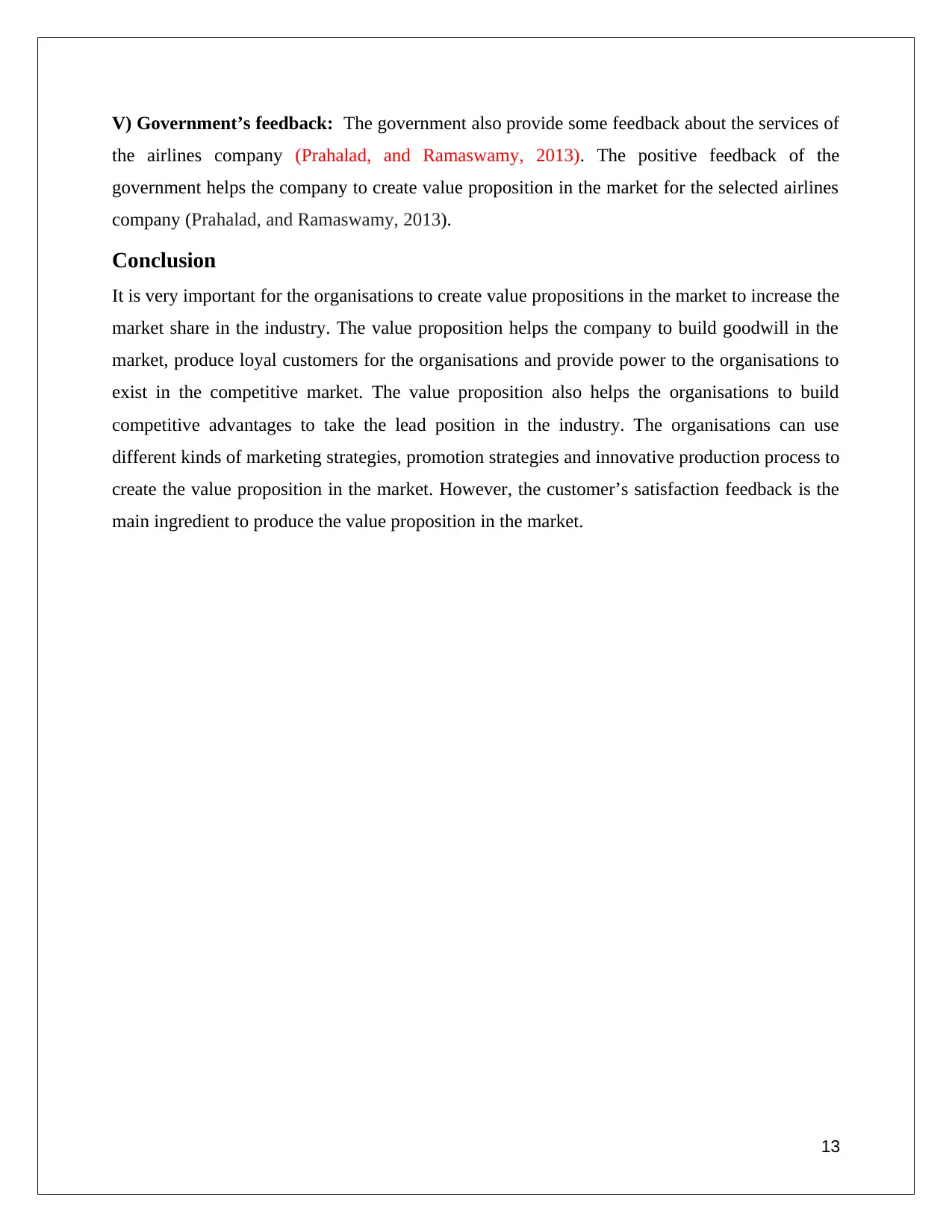
V) Government’s feedback: The government also provide some feedback about the services of
the airlines company (Prahalad, and Ramaswamy, 2013). The positive feedback of the
government helps the company to create value proposition in the market for the selected airlines
company (Prahalad, and Ramaswamy, 2013).
Conclusion
It is very important for the organisations to create value propositions in the market to increase the
market share in the industry. The value proposition helps the company to build goodwill in the
market, produce loyal customers for the organisations and provide power to the organisations to
exist in the competitive market. The value proposition also helps the organisations to build
competitive advantages to take the lead position in the industry. The organisations can use
different kinds of marketing strategies, promotion strategies and innovative production process to
create the value proposition in the market. However, the customer’s satisfaction feedback is the
main ingredient to produce the value proposition in the market.
13
the airlines company (Prahalad, and Ramaswamy, 2013). The positive feedback of the
government helps the company to create value proposition in the market for the selected airlines
company (Prahalad, and Ramaswamy, 2013).
Conclusion
It is very important for the organisations to create value propositions in the market to increase the
market share in the industry. The value proposition helps the company to build goodwill in the
market, produce loyal customers for the organisations and provide power to the organisations to
exist in the competitive market. The value proposition also helps the organisations to build
competitive advantages to take the lead position in the industry. The organisations can use
different kinds of marketing strategies, promotion strategies and innovative production process to
create the value proposition in the market. However, the customer’s satisfaction feedback is the
main ingredient to produce the value proposition in the market.
13
Paraphrase This Document
Need a fresh take? Get an instant paraphrase of this document with our AI Paraphraser
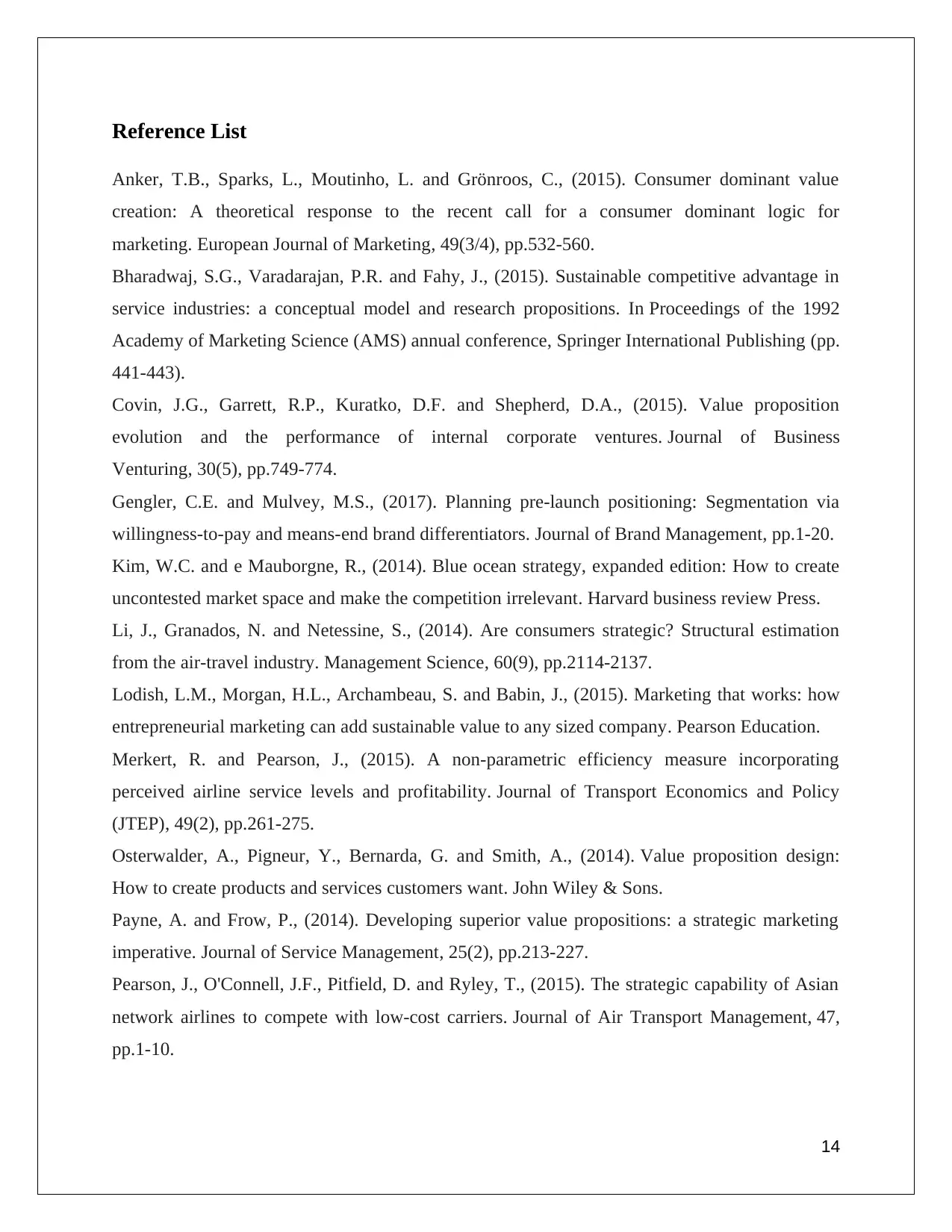
Reference List
Anker, T.B., Sparks, L., Moutinho, L. and Grönroos, C., (2015). Consumer dominant value
creation: A theoretical response to the recent call for a consumer dominant logic for
marketing. European Journal of Marketing, 49(3/4), pp.532-560.
Bharadwaj, S.G., Varadarajan, P.R. and Fahy, J., (2015). Sustainable competitive advantage in
service industries: a conceptual model and research propositions. In Proceedings of the 1992
Academy of Marketing Science (AMS) annual conference, Springer International Publishing (pp.
441-443).
Covin, J.G., Garrett, R.P., Kuratko, D.F. and Shepherd, D.A., (2015). Value proposition
evolution and the performance of internal corporate ventures. Journal of Business
Venturing, 30(5), pp.749-774.
Gengler, C.E. and Mulvey, M.S., (2017). Planning pre-launch positioning: Segmentation via
willingness-to-pay and means-end brand differentiators. Journal of Brand Management, pp.1-20.
Kim, W.C. and e Mauborgne, R., (2014). Blue ocean strategy, expanded edition: How to create
uncontested market space and make the competition irrelevant. Harvard business review Press.
Li, J., Granados, N. and Netessine, S., (2014). Are consumers strategic? Structural estimation
from the air-travel industry. Management Science, 60(9), pp.2114-2137.
Lodish, L.M., Morgan, H.L., Archambeau, S. and Babin, J., (2015). Marketing that works: how
entrepreneurial marketing can add sustainable value to any sized company. Pearson Education.
Merkert, R. and Pearson, J., (2015). A non-parametric efficiency measure incorporating
perceived airline service levels and profitability. Journal of Transport Economics and Policy
(JTEP), 49(2), pp.261-275.
Osterwalder, A., Pigneur, Y., Bernarda, G. and Smith, A., (2014). Value proposition design:
How to create products and services customers want. John Wiley & Sons.
Payne, A. and Frow, P., (2014). Developing superior value propositions: a strategic marketing
imperative. Journal of Service Management, 25(2), pp.213-227.
Pearson, J., O'Connell, J.F., Pitfield, D. and Ryley, T., (2015). The strategic capability of Asian
network airlines to compete with low-cost carriers. Journal of Air Transport Management, 47,
pp.1-10.
14
Anker, T.B., Sparks, L., Moutinho, L. and Grönroos, C., (2015). Consumer dominant value
creation: A theoretical response to the recent call for a consumer dominant logic for
marketing. European Journal of Marketing, 49(3/4), pp.532-560.
Bharadwaj, S.G., Varadarajan, P.R. and Fahy, J., (2015). Sustainable competitive advantage in
service industries: a conceptual model and research propositions. In Proceedings of the 1992
Academy of Marketing Science (AMS) annual conference, Springer International Publishing (pp.
441-443).
Covin, J.G., Garrett, R.P., Kuratko, D.F. and Shepherd, D.A., (2015). Value proposition
evolution and the performance of internal corporate ventures. Journal of Business
Venturing, 30(5), pp.749-774.
Gengler, C.E. and Mulvey, M.S., (2017). Planning pre-launch positioning: Segmentation via
willingness-to-pay and means-end brand differentiators. Journal of Brand Management, pp.1-20.
Kim, W.C. and e Mauborgne, R., (2014). Blue ocean strategy, expanded edition: How to create
uncontested market space and make the competition irrelevant. Harvard business review Press.
Li, J., Granados, N. and Netessine, S., (2014). Are consumers strategic? Structural estimation
from the air-travel industry. Management Science, 60(9), pp.2114-2137.
Lodish, L.M., Morgan, H.L., Archambeau, S. and Babin, J., (2015). Marketing that works: how
entrepreneurial marketing can add sustainable value to any sized company. Pearson Education.
Merkert, R. and Pearson, J., (2015). A non-parametric efficiency measure incorporating
perceived airline service levels and profitability. Journal of Transport Economics and Policy
(JTEP), 49(2), pp.261-275.
Osterwalder, A., Pigneur, Y., Bernarda, G. and Smith, A., (2014). Value proposition design:
How to create products and services customers want. John Wiley & Sons.
Payne, A. and Frow, P., (2014). Developing superior value propositions: a strategic marketing
imperative. Journal of Service Management, 25(2), pp.213-227.
Pearson, J., O'Connell, J.F., Pitfield, D. and Ryley, T., (2015). The strategic capability of Asian
network airlines to compete with low-cost carriers. Journal of Air Transport Management, 47,
pp.1-10.
14
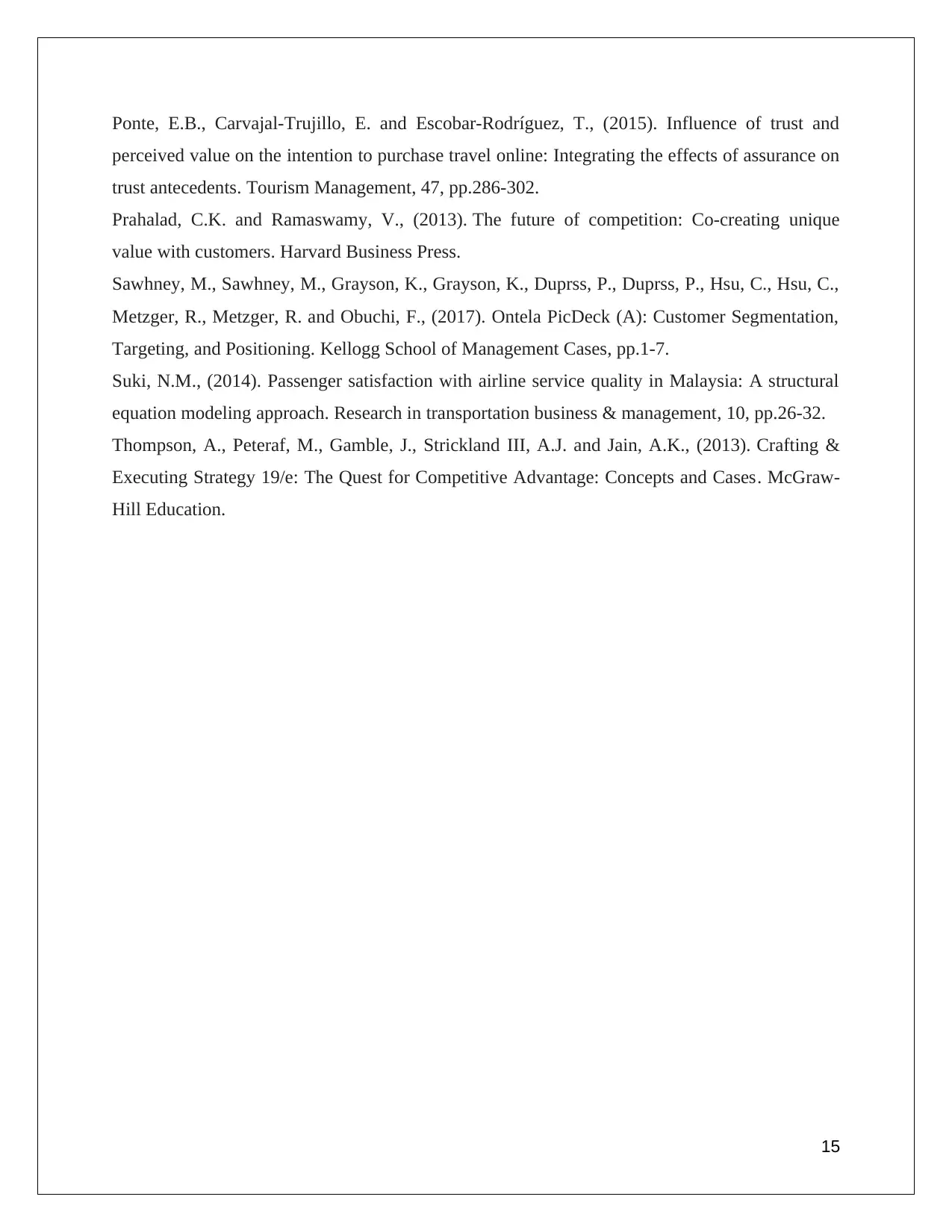
Ponte, E.B., Carvajal-Trujillo, E. and Escobar-Rodríguez, T., (2015). Influence of trust and
perceived value on the intention to purchase travel online: Integrating the effects of assurance on
trust antecedents. Tourism Management, 47, pp.286-302.
Prahalad, C.K. and Ramaswamy, V., (2013). The future of competition: Co-creating unique
value with customers. Harvard Business Press.
Sawhney, M., Sawhney, M., Grayson, K., Grayson, K., Duprss, P., Duprss, P., Hsu, C., Hsu, C.,
Metzger, R., Metzger, R. and Obuchi, F., (2017). Ontela PicDeck (A): Customer Segmentation,
Targeting, and Positioning. Kellogg School of Management Cases, pp.1-7.
Suki, N.M., (2014). Passenger satisfaction with airline service quality in Malaysia: A structural
equation modeling approach. Research in transportation business & management, 10, pp.26-32.
Thompson, A., Peteraf, M., Gamble, J., Strickland III, A.J. and Jain, A.K., (2013). Crafting &
Executing Strategy 19/e: The Quest for Competitive Advantage: Concepts and Cases. McGraw-
Hill Education.
15
perceived value on the intention to purchase travel online: Integrating the effects of assurance on
trust antecedents. Tourism Management, 47, pp.286-302.
Prahalad, C.K. and Ramaswamy, V., (2013). The future of competition: Co-creating unique
value with customers. Harvard Business Press.
Sawhney, M., Sawhney, M., Grayson, K., Grayson, K., Duprss, P., Duprss, P., Hsu, C., Hsu, C.,
Metzger, R., Metzger, R. and Obuchi, F., (2017). Ontela PicDeck (A): Customer Segmentation,
Targeting, and Positioning. Kellogg School of Management Cases, pp.1-7.
Suki, N.M., (2014). Passenger satisfaction with airline service quality in Malaysia: A structural
equation modeling approach. Research in transportation business & management, 10, pp.26-32.
Thompson, A., Peteraf, M., Gamble, J., Strickland III, A.J. and Jain, A.K., (2013). Crafting &
Executing Strategy 19/e: The Quest for Competitive Advantage: Concepts and Cases. McGraw-
Hill Education.
15
1 out of 15
Related Documents
Your All-in-One AI-Powered Toolkit for Academic Success.
+13062052269
info@desklib.com
Available 24*7 on WhatsApp / Email
![[object Object]](/_next/static/media/star-bottom.7253800d.svg)
Unlock your academic potential
© 2024 | Zucol Services PVT LTD | All rights reserved.





